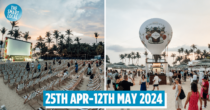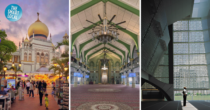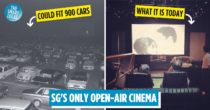Section 1: The Fortress and the City
This section is called The Fortress and the City, which showcases artefacts relating to fortified cities in the various Islamic kingdoms.
Artefact #1-1: Composite Capital
The first Muslims were Arabs who had led a nomadic lifestyle. When they began conquering other lands in West Asia which were mostly Christian, they became exposed to the urbanised cultures of the Byzantine Empire (based in Turkey) and the Sassanid Empire (based in Iran). The architecture, especially in the Byzantine Empire, was based on the Greek-Roman architecture, which features the use of pillars, arches and domes (refer to Hagia Sophia).
The following is a capital from the Spanish Umayyad era:
Figure 2.1: Composite CapitalIslamic Iberia
ca. 950-970 CE
Marble
Capitals are architectural elements that are placed on top of pillars to support the upper parts of the building (refer to example).
This capital is called the composite capital, because it is based on the designs of two types of Greek capitals:
- Ionic capital (refer to example) – characterised by its large volutes
- Corinthian capital (refer to example) – characterised by its small volutes and two rows of acanthus leaves.
The Composite capital has large volutes and two rows of acanthus leaves.
Although one can see influences from the Greek-Roman architecture, this style is uniquely of Islamic Spain (and also North Africa) due to its openwork carvings (refer to here and here).
Artefact #1-2: Capital with Animals
Contrast this capital with the composite capital we saw previously:
Figure 2.2: Capital with AnimalsEastern Syria or Iraq
First Half of 13th Century
Marble
This capital is from the Ayubbid period. Its carvings are so shallow that it is like looking at a drawing from afar. What is interesting about this capital is the pair of addorsed gryphons set in vegetal interlace. Do you see the gryphons? They are located at the mid to bottom part of the capital. This decorative design can be seen in Ayubbid arts of other media like their inlaid metalwork or carved wood.
Artefact #1-3: Mudejar Wooden Corbels
Corbels are architectural elements which jut out of the wall to support the weight of a certain part of the building. The museum has very creatively showcased the function of these corbels—they each support a ledge above them:
Figure 2.3: Mudejar Wooden CorbelsMudejar Spain, Toledo
14th Century
Oak
These corbels were made by the Mudejars. Mudejars were Spanish Muslims who refused to convert to Christianity after the Christians overthrew the last Islamic kingdom in Spain. One of the skills the Mudejars were well-known for was their woodworking. You can see the exquisite designs that were carved onto the wooden corbels.
Artefact #1-4: Humayun Defeats His Brother Kamran at Kabul
This is an early Mughal miniature about Humayun, its second emperor. Humayun had a brother Kamran who was the governor of Qandahar and Kabul, Afghanistan. Kamran had seized his lands and Humayun was exiled. Humayun then sought refuge with the Safavid Persians. With the Safavid’s support, Humayun then led a Mughal-Persian force into Qandahar and Kabul, and defeated Kamran. In this painting, Humayun is depicted in gold mail and mounted on a magnificent horse. Above him, Kamran (a bearded man in orange) is seen escaping.
Figure 2.4: Humayun Defeats His Brother Kamran at KabulAgra, India
ca. 1590-1596 CE
Opaque Watercolour and Gold on Paper
Folio from a Dispersed Manuscript of Akbarnama (Book of Akbar)
Inscribed ‘Painting by Mahish, Principal Faces by Padarath’
When Humayun was in Safavid Persia, Persia was famed for its miniature paintings. The ruler of the Safavids then decided to focus on carpets instead of miniature art. As a result, Safavid artists began migrating to other places in search of new patrons. Some of these artists followed Humayun to India. This explains why early Mughal paintings, like this one, tend to look very similar to Safavid Persian miniatures.
In the foreground, the battle scene is painted in Safavid Persian style:
- brightly coloured with gold illumination
- 2-dimensional
- with even lighting
- with no shadows or shades
- the people nearer the viewer are at the bottom, those further away are at the top
- very crowded battle scene portrayals
- usually with mountains for landscape portrayals
The background, however, is unique to early Mughal style. It is usually rendered in light colours to create an atmospheric effect of distance and haze.
It is common in early Mughal art to depict buildings in the background. In this background, Kabul is portrayed as a walled city with an arched gateway, crenellated walls, and grand buildings with domes, peaked roofs and arcades, all depicted in European style. The ethereal presence of this city represents the prize that Humayun was fighting for.
Artefact #1-5: Emperor Jahangir at the Jharoka Window at the Red Fort at Agra
This is another early Mughal miniature, with the Red Fort at Agra in the background. The Red Fort at Agra is a huge fortified complex and a palace-city.
There was an imperial tradition called darshan for the Mughal emperor to appear daily before his subjects. In this painting, Emperor Jahangir appears in a balcony window called a jharoka, which is very common in Indian architecture. His top-ranking officials stood in the marble terrace just below him. The lower-ranking officials and and the public gather in the courtyard below.
Figure 2.5: Emperor Jahangir at the Jharoka Window at the Red Fort at AgraAgra, India
ca. 1620 CE
Watercolour, Ink and Gold on Paper
Folio from Manuscript of Jahangirnama (Book of Jahangir)
In the left is a chain of bells, known as the ‘Chain of Justice’. Anyone who felt that he had been wronged could pull the bells to attract the attention of the emperor. However, in reality, there are men with sticks (one of the men is in purple) to chase away those who tried to ring the bells.
Artefact #1-6: Moses Regrets His Generosity Towards the Intemperate Man
West Asia is the birth place of the 3 great monotheistic religions—Judaism, Christianity, and Islam. Adherents of all these 3 religions revere many of the same prophets. One such prophet is Moses.
Figure 2.6: Moses Regrets His Generosity Towards the Intemperate ManMughal India
ca. 1604 CE
Watercolour, Ink and Gold on Paper
Folio from a Manuscript of the Kulliyat of Sa’di
This early Mughal miniature depicts a story of the Prophet Moses, who met a starving man one day. At the man’s request, Moses prayed to God to provide for him. A few days later, Moses saw the same man surrounded by a group of angry people. He was told that the man had become wealthy, but got himself drunk and committed murder. This miniature shows the man being led away for his execution, and Moses realised he should not have presumed to pray for such an undeserving person.
One Safavid Persia characteristic can be seen in this painting, and that is the main character is portrayed is larger than the others. Can you identify which person is Moses? (Hint: Look for the largest person in the painting.)
Remember that buildings in the background are common in early Mughal style? Note the beautiful palace-city in the background. The high viewpoint permits a detailed depiction of the interior structures. Later Indian painters used this method to depict real buildings.
The luxurious but deserted palace-city could symbolise the transience of worldly wealth. A person may own the palace-city, but he in time will pass away, as will all things. Material wealth is never permanent.
Artefact #1-7: Wooden Beam with Inscription
3 types of motifs form the building blocks of Islamic art. They are
- geometric
- floral/vegetal/arabesque, and
- calligraphic motifs.
Of the three, calligraphy is the most important, because it is the means by which the Muslim receives knowledge and understands the divine revelations of Allah.
Figure 2.7: Wooden Beam with InscriptionProbably Nasrid Iberia
14th Century Wood
This wooden beam shows Arabic text intertwined with scrolls of leaves and vines. This makes the text difficult to decipher. The Arabic script, or font, used is the angular kufic script (see example), which is characterised by long horizontals and short verticals. Kufic script is commonly used for decorative purpose. Are you able to see at least part of the text? Look for the horizontals, verticals, U-shapes and inverted U-shapes.
Note that Arabic texts read from right to left, no matter what scripts or fonts are used.
Artefact #1-8: Shah Ramin and Companions before the Marvellous City of Dar ul-Bekam
This miniature is from Ottoman Turkey. There is strong influence from Safavid Persian miniatures, which are:
- brightly coloured
- with even lighting
- with no shadow or shades
- usually with mountains in landscape portrayals
However, you can tell this is an Ottoman painting because of the black beauty spots on the main characters’ faces.
Figure 2.8: Shah Ramin and Companions before the Marvellous City of Dar ul-BekamIstanbul, Turkey
ca. 1593 CE
Watercolour, Ink, Gold and Silver on Paper
From the Manuscript ‘Gifts of Curiosities’
This is a story of a young prince called Shah Ramin and his companions. Shah Ramin had heard of a fantastical city called the Dar ul-Bekam, and set out to find it. This scene shows Shah Ramin and his companions beholding the magical stronghold for the first time. They raised their fingers to their lips in the gesture of astonishment. Can you tell which figure is Shah Ramin? (Hint: He is the one with the black beauty spots on his face.)
The fortress was guarded by 4 towers, which looked very much like the thin, balconied minarets of an Ottoman mosque (refer to Sokollu Mehmet Pasha Mosque). Each tower carried a talismanic figure in the form of a mounted warrior wielding a weapon. The metal warriors were mounted on 4 different types of steeds:
- lion
- elephant
- unicorn and
- horse.
The idea in the story of these 4 mounted warriors could be based on historical references to the audience hall of the Abbasid caliph al-Mansur. The audience hall was said to have 4 fabled mounted figures adorning its 4 domes.
In this scene, the 4 metal knights faced Shah Ramin menacingly, and when the young prince opened the gate of the city, the mouths of the 4 warriors emitted a flood of water which threatened to drown the prince and his companions, before it eventually drained away into the moat. The moat was painted in silver, but has turned black due to oxidation.
We have just seen architectural elements, buildings and cities in the Islamic World. Although some portrayals are fictional, the buildings or cities depicted were very often based on actual buildings and cities. These artefacts provide us with insight into the lives and times of the Islamic World.
We will proceed to the next section called Sacred Topographies. Stay tuned!
References
- Treasures of the Aga Khan Museum: Architecture in Islamic Arts. PP 146-153, 156-161, 168-169, 172-173.
- Wikipedia – Composite Order: http://en.wikipedia.org/wiki/Composite_order
- Wikipedia – Mudejar: http://en.wikipedia.org/wiki/Mudéjar
- Wikipedia – Persian Miniature: http://en.wikipedia.org/wiki/Persian_miniature

Drop us your email so you won't miss the latest news.









